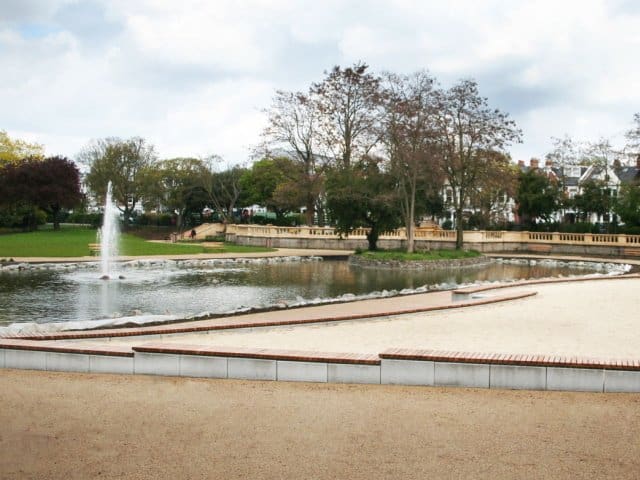Bishop’s Park: Fulham’s most popular recreation spot
- Date: 29/Mar/2024
- Comments: 0
Situated next to the River Thames, Bishop’s Park is in the south of the borough of Hammersmith and Fulham. It runs along an embankment path and tree-lined avenue from All Saints Church to Bishop’s Park Road.
It is one of the most popular and most well-used parks in the area and is on the English Heritage Register of Parks and Gardens as a Grade II listed park.
Park Facilities

Bishop’s Park has something for everyone. There are two playgrounds, one for younger children and one for older children. There is also a skate bowl, table tennis tables, a basketball hoop and a water play area that is open seasonally.
In terms of sports, Bishop’s Park is home to Winnington Bowls Club and has some bowling greens. You can also hire tennis courts or join a tennis programme. More information can be found on this website. For the runners amongst you, there is a weekly Parkrun here too.
If you’re looking at enjoying the beauty of this park, it is home to an ornamental lake, an urban beach, two meadows, a path along the Thames, a moat garden, a sculpture garden, a rose garden, Pryor’s Back garden and a Spanish War Memorial garden.
Events in Bishop’s Park

There are two major events each year in Bishop’s Park. In November, there is a fireworks display that attracts a lot of visitors and in March there is the Oxford-Cambridge Boat Race. Smaller events include food markets and farmers’ markets.
Bishop’s Park History

Bishop’s Park was opened formally in 1893 by Sir John Hutton who was chairman of the LCC. Parts of the park included West Meadow, Bishop’s Meadow and Bishop’s Walk. These were conveyed to the Fulham District Board of Works by the Ecclesiastical Commissioners so long as the land was kept for public recreation.
In 1894, there was an extension to the park to include Pryor’s Bank and gardens. These gardens contain sculptures of stone figures that depict Leda, Grief, Protection and Adoration.
They were presented to the park by J Wedgewood. Another sculpture depicting a mother and child called “Affection” was added alongside the other sculptures in 1963. This was by Herman Cawthorn.
In February 2011, the park gained a successful lottery bid and had a major refurbishment and restoration.
Bishop’s Park Development

There are plans for the park to enter into a lease with Fulham FC. This will mean the football club will use some of Fielders Meadow as a compound whilst the Riverside Stand is being redeveloped inside Craven Cottage Stadium.
Unfortunately for tree-lovers, this will mean the loss of some mature trees. The Friends of Bishop’s Park did ask the contractor if they could move the compound entrance, but this would also mean tree removal.
There are two mature trees that will be removed for the entrance of the compound. However, as these are mature trees they would need tree removal services within the next decade anyway. The trees due for removal are a Tree of Heaven and a London Plane tree.
There is also a Robinia that will need to be removed as it has a fungus and some smaller trees and scrub. Once the works are completed, all three trees will be replaced. The smaller trees will be replaced with three times the number of trees.
There is also a restoration project underway in Bishop’s Park. Phase 3 of this involves improving the views in the grounds and opening areas, creating space for new paths and replanting.
There will be some tree removal, but these are mostly self-sown sycamores, which are not historically relevant to Bishop’s Park or Fulham Palace. These trees are causing overcrowding and are causing deformities in other trees.
With these trees removed, it is hoped that space will be more open and will feel more interconnected between the River Thames, Bishop’s Park and Fulham Palace.
The renovation project has an aim to re-introduce historic plants that would have been in the first gardens grown by Bishop Compton between 1675 and 1713. There will also be space for some new tree planting and shrub planting.
Significant Trees in Bishop’s Park

Henry Compton was a very keen gardener and a serious botanist. He arranged for many rare plants to come over from North America. He was able to do this as he exploited his position of being responsible for the Church of England in the British Colonies.
This meant that there were lots of unusual trees in Bishop’s Park including Judas trees, Tulip trees, Honey Locusts, Black Walnuts, Virginian Red Cedars and Lebanon Cedars.
Of course, we can’t mention trees in Bishop’s Park without mentioning the very ‘instagrammable’ avenue of London plane trees that tower over Bishop’s Park southern entrance. This avenue is also the main avenue leading to Fulham Palace.
Fulham Palace

Fulham Palace lies adjacent to Bishop’s Park and is a grade I listed building. It used to be the principal residence of London Bishop’s – hence the name Bishop’s Park. It housed the Bishop of London from at least the 11th century right up until as recently as 1973. The palace is still under the ownership of the Church of England but it is managed by the charity Fulham Palace Trust. Nowadays, it is a museum depicting its history and showing some historic rooms that have been restored.
The botanic garden and palace garden both belong to Fulham Palace and the former extends over 13 acres while the latter is a grade II park on the Register of Historic Parks and Gardens.
The garden at Fulham Palace has seen a lot of change over the centuries and reflects the power, wealth and interests of the many Bishops who resided there. The layout of the garden today is largely influenced by Bishop Terrick who made changes to it towards the end of the 18th century. Bishop Terrick did some landscaping to incorporate views of the river. He also built the walled garden and incorporated a Tudor wall that was already in place.
The land that is now Bishop’s Park used to be part of the estate but this was sold off or donated.
Being free to visit, Fulham Palace attracts a lot of visitors each year (around 400,000) and a lot of these visitors also go on to explore Bishop’s Park.
What’s great about the gardens at Fulham Palace is that so many people volunteer to help out. There are around 30 volunteer gardeners, which is tremendous.
Article was written by Louise W.
Article Source: https://www.graftingardeners.co.uk/bishops-park/

































